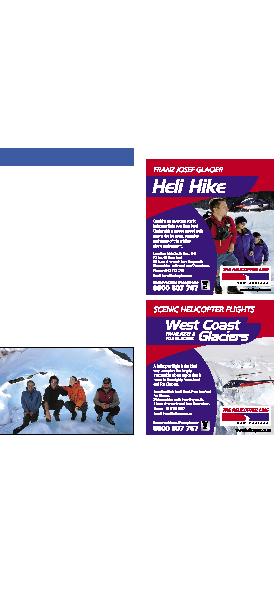
57
56
GLACIOLOGY
The Fox and Franz Josef Glaciers
cut through dramatic glacial
valleys to flow into temperate
rainforest. While many
glaciers world-wide have been
retreating, these glaciers still
flow almost to sea level, making
them unique relics of the last
Ice Age.
South-Westland lies in the path
of a band of wind known as the
`roaring forties'. The weather
that flows on to the West
Coast is forced to rise over the
Southern Alps, thereby cooling
and dropping most of its
moisture as rain and snow. This
process causes approximately
30 metres of snow to fall on
the neve, or catchment area
of the glacier every year. Snow
that is compacted on the neve
forms blue glacier ice that is
funnelled down the valleys
of the Franz Josef and Fox
Glaciers. This flows under its
own momentum, forming these
`rivers of ice' which are easily
accessible from the Waiho
(Franz Josef) and Cook (Fox)
river beds.
Although much melt occurs
from the surface of the glaciers
at lower elevations (the ablation
zone), this high snowfall
continues to push ice down the
valleys at very high rates. This
is aided by basal sliding, caused
by a layer of water beneath the
glaciers, formed by the weight
of the ice pushing against
the valley floor. Both of these
factors cause the Franz Josef
and Fox Glaciers to have flow
rates that are up to 10 times
faster than most valley glaciers.
The glaciers flow over large
bedrock steps on the valley
floors. This causes the ice to
extend and break up, forming
steep icefalls that are mazes
of crevasses and pinnacles of
ice. Spectacular views of this
dramatic landscape are gained
from short valley walks to the
Franz Josef and Fox Glacier
terminal faces, or by taking
a guided walk on to the ice.
Either option will provide any
visitor with a unique glacier
experience.
Glaciers
Fox Glacier Guiding

